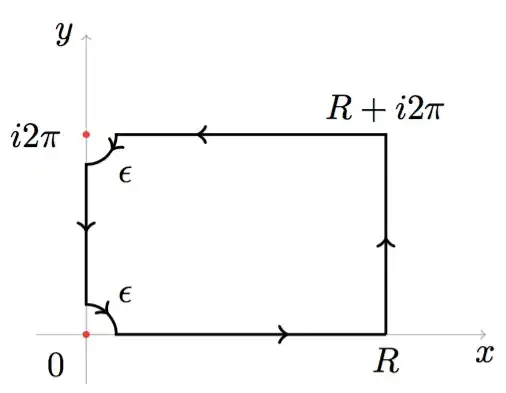I would have guessed this was a duplicate, but I wasn't able to find another instance of this question during a cursory search.
Hint The denominator has period $2 \pi i$, which suggests using the following contour $\Gamma_{\epsilon, R}$, $0 < \epsilon < \pi$, $\epsilon < R$, (for which an illustration was already drawn for an answer to the similar question linked by Zacky in the comments):

The key trick here, which we apply with the benefit of hindsight, is to evaluate instead the similar integral $$\int_{\Gamma_{\epsilon, R}} \frac{z^2 \,dz}{e^z - 1} .$$
The interior of $\Gamma_{\epsilon, R}$ contains no poles, so this integral vanishes. Thus, parameterizing the constituent arcs of the contour gives
\begin{multline}
0 = \underbrace{\int_\epsilon^R \frac{x^2 \,dx}{e^x - 1}}_{A} + \underbrace{\int_0^{2 \pi} \frac{(R + i y)^2 \cdot i \,dy}{e^{R + i y} - 1}}_{B} + \underbrace{\int_R^\epsilon \frac{(x + 2 \pi i)^2 \,dx}{e^x - 1}}_{C} \\ + \underbrace{\int_0^{-\pi / 2} \frac{(2 \pi i + \epsilon e^{i\theta})^2 \cdot i \epsilon e^{i \theta} d \theta}{e^{\epsilon e^{i \theta}} - 1}}_{D} + \underbrace{\int_{2 \pi - \epsilon}^\epsilon \frac{(i y)^2 \cdot i \,dy}{e^{i y} - 1}}_{E} + \underbrace{\int_{\pi / 2}^0 \frac{(\epsilon e^{i\theta})^2 \cdot i \epsilon e^{i \theta} d \theta}{e^{\epsilon e^{i \theta}} - 1}}_{F} . \qquad (\ast)
\end{multline}
A standard bounding argument shows that $B \to 0$ as $R \to \infty$. Computing the first terms of the Taylor series gives that the integrand of $D$ is $-4 \pi^2 i + O(\epsilon)$, so $D = 2 \pi^3 i + O(\epsilon)$, and similarly $F = O(\epsilon)$ (in fact, the integrand is analytic at $0$, which implies this without any more computation). Now, expanding the integrand of $C$ gives $$-\int_\epsilon^R \frac{x^2 \,dx}{e^x - 1} = -\int_\epsilon^R \frac{x^2 \,dx}{e^x - 1} - 4 \pi i \int_\epsilon^R \frac{x \,dx}{e^x - 1} + 4 \pi^2 \int_\epsilon^R \frac{\,dx}{e^x - 1} .$$ The first term on the r.h.s. cancels $A$, and after taking appropriate limits the second term will be constant multiple of the integral $\color{#df0000}{\int_0^\infty \frac{x \,dx}{e^x - 1}}$ of interest. The third term diverges as $\epsilon \searrow 0$, and it turns out that the diverging part of this term in $\epsilon$ is canceled by the diverging part of $E$, but we can avoid dealing with this issue directly by passing to the imaginary part of $(\ast)$. Computing gives $\operatorname{Im} E = -\frac{1}{2} \int_\epsilon^{2 \pi - \epsilon} y^2 \,dy = -\frac{4}{3} \pi^3 + O(\epsilon)$, so taking the limits $\epsilon \searrow 0, R \to \infty$ of the imaginary part of $(\ast)$ leaves $$0 = -4 \pi \color{#df0000}{\int_0^\infty \frac{x\,dx}{e^x - 1}} + 2 \pi^3 - \frac{4}{3} \pi^3 ,$$ and rearranging gives the desired result, $$\color{#df0000}{\boxed{\int_0^\infty \frac{x \,dx}{e^x - 1} = \frac{\pi^2}{6}}} .$$
